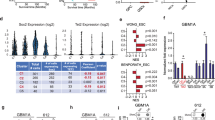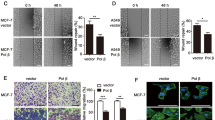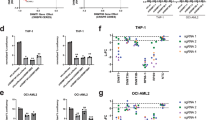Abstract
The cytosine analogues 5-azacytidine and 5-aza-2′-deoxycytidine are currently the most advanced drugs for epigenetic cancer therapy. Both drugs function as DNA methyltransferase (DNMT) inhibitors and lead to the reactivation of epigenetically silenced tumour suppressor genes. However, not much is known about their target sequence specificity and their possible side effects on normally methylated sequences such as long interspersed nuclear element (LINE)-1 retroelements. It has been shown that demethylation and activation of the LINE-1 antisense promoter can drive the transcription of neighbouring sequences. In this study, we show that demethylation of the colon carcinoma cell line HCT116, either by treatment with DNMT inhibitors or by genetic disruption of the major DNMTs, induces the expression of an illegitimate fusion transcript between an intronic LINE-1 element and the proto-oncogene cMet (L1-cMet). Similar findings were also obtained with myeloid leukaemia cells, an established cellular model for the approved indication of azacytidine and decitabine. Interestingly, upregulation of L1-cMet transcription resulted in reduced cMet expression, which in turn led to decreased cMet receptor signalling. Our results thus provide an important paradigm for demethylation-dependent modulation of gene expression, even if the promoter of the corresponding gene is unmethylated.
This is a preview of subscription content, access via your institution
Access options
Subscribe to this journal
Receive 50 print issues and online access
$259.00 per year
only $5.18 per issue
Buy this article
- Purchase on Springer Link
- Instant access to full article PDF
Prices may be subject to local taxes which are calculated during checkout







Similar content being viewed by others
References
Birchmeier C, Birchmeier W, Gherardi E, Vande Woude GF . (2003). Met, metastasis, motility and more. Nat Rev Mol Cell Biol 4: 915–925.
Boyd KE, Farnham PJ . (1999). Coexamination of site-specific transcription factor binding and promoter activity in living cells. Mol Cell Biol 19: 8393–8399.
Breiling A, Turner BM, Bianchi ME, Orlando V . (2001). General transcription factors bind promoters repressed by Polycomb group proteins. Nature 412: 651–655.
Chuang JC, Yoo CB, Kwan JM, Li TW, Liang G, Yang AS et al. (2005). Comparison of biological effects of non-nucleoside DNA methylation inhibitors versus 5-aza-2′-deoxycytidine. Mol Cancer Ther 4: 1515–1520.
Cruickshanks HA, Tufarelli C . (2009). Isolation of cancer-specific chimeric transcripts induced by hypomethylation of the LINE-1 antisense promoter. Genomics 94: 397–406.
Egger G, Liang G, Aparicio A, Jones PA . (2004). Epigenetics in human disease and prospects for epigenetic therapy. Nature 429: 457–463.
Ehrlich M . (2002). DNA methylation in cancer: too much, but also too little. Oncogene 21: 5400–5413.
Esteller M . (2007). Cancer epigenomics: DNA methylomes and histone-modification maps. Nat Rev Genet 8: 286–298.
Feinberg AP, Ohlsson R, Henikoff S . (2006). The epigenetic progenitor origin of human cancer. Nat Rev Genet 7: 21–33.
Gius D, Cui H, Bradbury CM, Cook J, Smart DK, Zhao S et al. (2004). Distinct effects on gene expression of chemical and genetic manipulation of the cancer epigenome revealed by a multimodality approach. Cancer Cell 6: 361–371.
Gore SD, Baylin S, Sugar E, Carraway H, Miller CB, Carducci M et al. (2006). Combined DNA methyltransferase and histone deacetylase inhibition in the treatment of myeloid neoplasms. Cancer Res 66: 6361–6369.
Howard G, Eiges R, Gaudet F, Jaenisch R, Eden A . (2008). Activation and transposition of endogenous retroviral elements in hypomethylation induced tumors in mice. Oncogene 27: 404–408.
Issa JP, Kantarjian HM . (2009). Targeting DNA methylation. Clin Cancer Res 15: 3938–3946.
Jones BK, Levorse JM, Tilghman SM . (1998). Igf2 imprinting does not require its own DNA methylation or H19 RNA. Genes Dev 12: 2200–2207.
Jones PA, Baylin SB . (2007). The epigenomics of cancer. Cell 128: 683–692.
Juttermann R, Li E, Jaenisch R . (1994). Toxicity of 5-aza-2′-deoxycytidine to mammalian cells is mediated primarily by covalent trapping of DNA methyltransferase rather than DNA demethylation. Proc Natl Acad Sci USA 91: 11797–11801.
Kantarjian H, Issa JP, Rosenfeld CS, Bennett JM, Albitar M, DiPersio J et al. (2006). Decitabine improves patient outcomes in myelodysplastic syndromes: results of a phase III randomized study. Cancer 106: 1794–1803.
Lyko F, Brown R . (2005). DNA methyltransferase inhibitors and the establishment of epigenetic cancer therapies. J Natl Cancer Inst 97: 1498–1506.
Martianov I, Ramadass A, Serra Barros A, Chow N, Akoulitchev A . (2007). Repression of the human dihydrofolate reductase gene by a non-coding interfering transcript. Nature 445: 666–670.
Mazo A, Hodgson JW, Petruk S, Sedkov Y, Brock HW . (2007). Transcriptional interference: an unexpected layer of complexity in gene regulation. J Cell Sci 120: 2755–2761.
Mund C, Brueckner B, Lyko F . (2006). Reactivation of epigenetically silenced genes by DNA methyltransferase inhibitors: basic concepts and clinical applications. Epigenetics 1: 7–13.
Mund C, Hackanson B, Stresemann C, Lubbert M, Lyko F . (2005). Characterization of DNA demethylation effects induced by 5-Aza-2′-deoxycytidine in patients with myelodysplastic syndrome. Cancer Res 65: 7086–7090.
Nigumann P, Redik K, Matlik K, Speek M . (2002). Many human genes are transcribed from the antisense promoter of L1 retrotransposon. Genomics 79: 628–634.
Novakovic B, Wong NC, Sibson M, Ng HK, Morley R, Manuelpillai U et al. (2010). DNA methylation-mediated down-regulation of DNA methylatransferase-1 (DNMT1), is co-incident with, but not essential for, global hypomethylation in human placenta. J Biol Chem 285: 9583–9593.
Palii SS, Van Emburgh BO, Sankpal UT, Brown KD, Robertson KD . (2007). The DNA methylation inhibitor 5-aza-2′-deoxycytidine (5-azadC) induces reversible genome-wide DNA damage that is distinctly influenced by DNA methyltransferases (DNMTs) 1 and 3B. Mol Cell Biol 28: 752–771.
Qin T, Jelinek J, Si J, Shu J, Issa JP . (2009). Mechanisms of resistance to 5-aza-2′-deoxycytidine in human cancer cell lines. Blood 113: 659–667.
Rhee I, Bachman KE, Park BH, Jair KW, Yen RW, Schuebel KE et al. (2002). DNMT1 and DNMT3b cooperate to silence genes in human cancer cells. Nature 416: 552–556.
Roman-Gomez J, Jimenez-Velasco A, Agirre X, Cervantes F, Sanchez J, Garate L et al. (2005). Promoter hypomethylation of the LINE-1 retrotransposable elements activates sense/antisense transcription and marks the progression of chronic myeloid leukemia. Oncogene 24: 7213–7223.
Santi DV, Norment A, Garrett CE . (1984). Covalent bond formation between a DNA-cytosine methyltransferase and DNA containing 5-azacytosine. Proc Natl Acad Sci USA 81: 6993–6997.
Schuebel KE, Chen W, Cope L, Glockner SC, Suzuki H, Yi JM et al. (2007). Comparing the DNA hypermethylome with gene mutations in human colorectal cancer. PLoS Genet 3: 1709–1723.
Schulz WA, Steinhoff C, Florl AR . (2006). Methylation of endogenous human retroelements in health and disease. Curr Top Microbiol Immunol 310: 211–250.
Silverman LR, Demakos EP, Peterson BL, Kornblith AB, Holland JC, Odchimar-Reissig R et al. (2002). Randomized controlled trial of azacitidine in patients with the myelodysplastic syndrome: a study of the cancer and leukemia group B. J Clin Oncol 20: 2429–2440.
Speek M . (2001). Antisense promoter of human L1 retrotransposon drives transcription of adjacent cellular genes. Mol Cell Biol 21: 1973–1985.
Stresemann C, Bokelmann I, Mahlknecht U, Lyko F . (2008). Azacytidine causes complex DNA methylation responses in myeloid leukemia. Mol Cancer Ther 7: 2998–3005.
Stresemann C, Brueckner B, Musch T, Stopper H, Lyko F . (2006). Functional diversity of DNA methyltransferase inhibitors in human cancer cell lines. Cancer Res 66: 2794–2800.
Vesely J, Cihak A, Sorm F . (1967). Biochemical mechanisms of drug resistance. IV. Development of resistance to 5-azacytidine and simultaneous depression of pyrimidine metabolism in leukemic mice. Int J Cancer 2: 639–646.
Walsh CP, Chaillet JR, Bestor TH . (1998). Transcription of IAP endogenous retroviruses is constrained by cytosine methylation. Nat Genet 20: 116–117.
Weisenberger DJ, Velicescu M, Cheng JC, Gonzales FA, Liang G, Jones PA . (2004). Role of the DNA methyltransferase variant DNMT3b3 in DNA methylation. Mol Cancer Res 2: 62–72.
Yang AS, Doshi KD, Choi SW, Mason JB, Mannari RK, Gharybian V et al. (2006). DNA methylation changes after 5-aza-2′-deoxycytidine therapy in patients with leukemia. Cancer Res 66: 5495–5503.
Yang AS, Estecio MR, Doshi K, Kondo Y, Tajara EH, Issa JP . (2004). A simple method for estimating global DNA methylation using bisulfite PCR of repetitive DNA elements. Nucleic Acids Res 32: e38.
Acknowledgements
We thank Achim Breiling and Azeemudeen Hussain for their advice and support in chromatin immunoprecipitation and cMet signalling analysis. This work was supported by the Cooperation Program in Cancer Research of the Deutsches Krebsforschungszentrum (DKFZ) and by the Israeli Ministry of Science and Technology (MOST).
Author information
Authors and Affiliations
Corresponding authors
Ethics declarations
Competing interests
The authors declare no conflict of interest.
Additional information
Supplementary information accompanies the paper on the Oncogene website
Supplementary information
Rights and permissions
About this article
Cite this article
Weber, B., Kimhi, S., Howard, G. et al. Demethylation of a LINE-1 antisense promoter in the cMet locus impairs Met signalling through induction of illegitimate transcription. Oncogene 29, 5775–5784 (2010). https://doi.org/10.1038/onc.2010.227
Received:
Revised:
Accepted:
Published:
Issue Date:
DOI: https://doi.org/10.1038/onc.2010.227
Keywords
This article is cited by
-
Evaluation of global and intragenic hypomethylation in colorectal adenomas improves patient stratification and colorectal cancer risk prediction
Clinical Epigenetics (2021)
-
Coordination of retrotransposons and type I interferon with distinct interferon pathways in dermatomyositis, systemic lupus erythematosus and autoimmune blistering disease
Scientific Reports (2021)
-
MET canonical transcript expression is a predictive biomarker for chemo-sensitivity to MET-inhibitors in hepatocellular carcinoma cell lines
Journal of Cancer Research and Clinical Oncology (2021)
-
Measuring and interpreting transposable element expression
Nature Reviews Genetics (2020)
-
Oxidative DNA damage induces hypomethylation in a compromised base excision repair colorectal tumourigenesis
British Journal of Cancer (2017)



